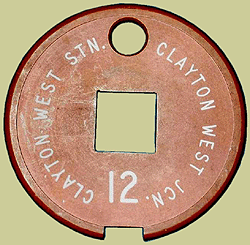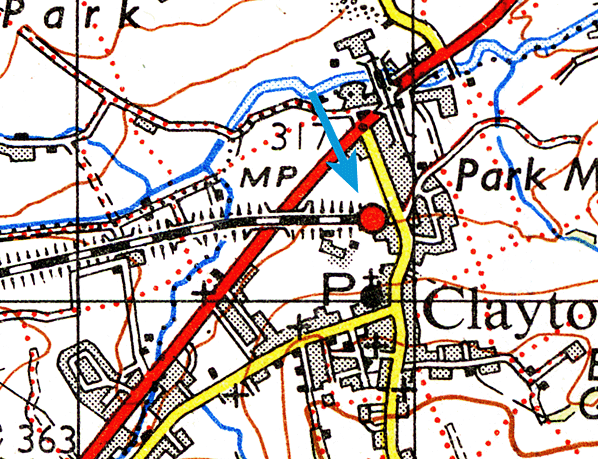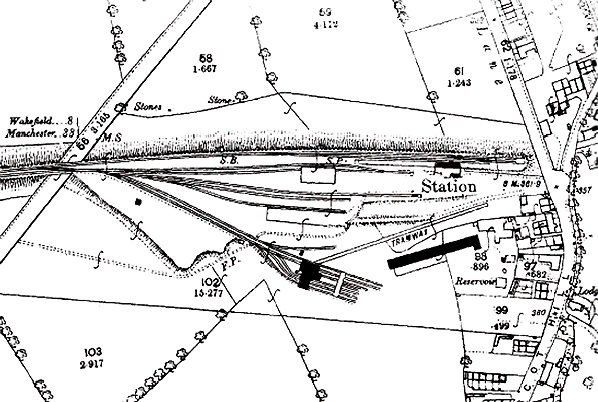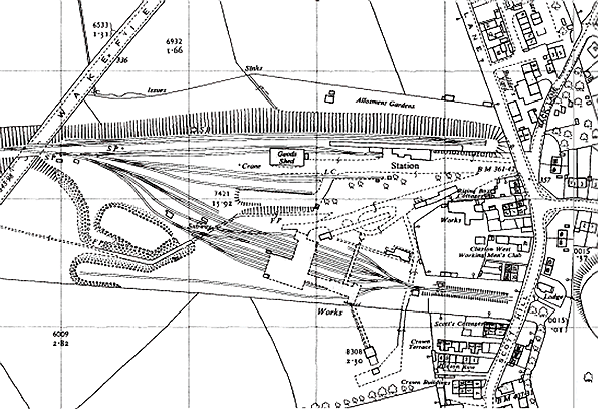|
Notes: Clayton West had a single platform on the up side. There was a T-plan sandstone building with a hipped slate roof. The long faces fronted onto the platform with the short face, which included the station entrance, projecting into the station forecourt. The building incorporated the booking office, station office, general waiting room and ladies’ waiting room. At the west end of the building there was a smaller stone building with a flat roof and entrance at the rear; this housed the gents’ toilets. Three signs projecting from the building identified from west to east: 'Gentlemen', 'General Room' and 'Way Out'. The ‘Way Out’ sign was at the east end of the building and indicated that passengers should use a gate in the fence to exit directly onto the station forecourt.
A wide canopy stretched the full length of the building; it had hipped glazed panels and a saw-tooth valance. The canopy was removed in the late 1950s, shortly before steam traction on the branch gave way to DMUs.
 |
The goods yard was behind the station on the up side and comprised three sidings plus a loop, one side of which passed through a large stone goods shed and ended at the rear of the platform. There was also a 5-ton crane at the west end of the goods shed between the loop and the other three sidings. A further pair of sidings ran south-east into Park Mill Colliery; further |
sidings were added as the colliery expanded. A signal box on the down side, 50yd west of the platform, controlled access to the goods yard and colliery sidings. The box was built by Saxby & Farmer to a very similar design to the boxes at Drayton and Boston Road.The original Saxby & Farmer frame was replaced by British Railways in 1961 with their standard type of frame (of Mckenzie & Holland design) comprising twenty levers. The nameplate on the front of the box was probably original, having escaped the LMS renewal programme. The box remained in use until closure of the branch.
Clayton West yard closed to goods traffic on 7 September 1970 although by that date it had been downgraded to a public delivery siding. The rails were quickly lifted but the sidings into the colliery remained in use until c1980. The colliery closed in 1989.
British Railways’ lack of confidence in the future of the route between Huddersfield and Penistone and the Clayton West branch can be inferred from BR North Eastern Region de-staffing all intermediate stations in August 1966, some time before many of the other lines in eastern and north-eastern England underwent this treatment when ‘Paytrains’ were introduced. Clayton West was the only station to retain booking facilities, but it, too, was shown as unstaffed in the timetable commencing 3 May 1970. British Rail was also reluctant to invest in upgrading these stations which (with the exception of Stocksmoor) remained gas- or oil-lit until the mid 1970s and did not receive totem signage. However in the late 1960s Clayton West received electric lamps, and Corporate Identity nameboards were fitted in the early 1970s: one was on the gents' toilet, while a second was unconventionally placed on the opposite side of the track near the west end of the platform. After closure in January 1983 the track was lifted in early 1986.
In 1989 the trackbed was leased to the Kirklees Light Railway, and a Light Railway Order was granted on 27 September 1991. The line opened on 19 October 1991 and was originally one mile in length, running from Clayton West station to a specially constructed halt called Cuckoos Nest. The new station at Clayton West was a little to the west of the original terminus. The L&W station building remained in place but the platform was shortened, with a new ramp at the west end, to accommodate the new KLR station. A depot and workshop was built on the trackbed in front of the L&Y station building. The building was eventually demolished in 2000 as it was considered uneconomic to restore it. The stone toilet block was retained as was the truncated platform.
BRIEF HISTORY OF THE CLAYTON WEST BRANCH (From Friends of Kirklees Light Railway web site) with some additions.
The origins of the Clayton West branch are found in the railway politics of the mid 1800s. The original proposal was to create a branch from the new Huddersfield & Sheffield Junction Railway (H&SJR) to Darton, near Barnsley. The line was to be known as the Darfield branch: it is unclear why the name was chosen as Darton would have appeared a more suitable target, and it is possible that the names were simply confused. This scheme would have involved a large amount of civil engineering including a tunnel of over a mile in length and a long high viaduct, but it was rejected by the House of Commons.
| Other railway companies started casting their eyes over the lucrative South Yorkshire coal field traffic and were promoting alternative routes. The London & North Western Railway (LNWR) proposed to build a branch from their Leeds main line through Deighton to Kirkburton, thereby making a move towards the Barnsley coal field. The Midland Railway (MR) then |
 |
proposed to extend the LNWR route to join its own branch at Barnsley. The LNWR disapproved of this idea and, in the end, the MR built its own line to Huddersfield - which was even less to the liking of the LNWR. In the end the two companies came to a compromise which involved mutual running powers and a joint station at Kirkburton. This scheme was passed by the House of Commons but fell foul of the House of Lords. Yet another mutual agreement was reached, this time between the MR and the Lancashire & Yorkshire Railway (L&YR) which gave the MR running powers over H&SJR; the LNWR in due course completed its line only as far as Kirkburton. The MR never used the running powers over the H&SJR, but the L&YR was eventually forced to honour one of the conditions, which was to build the Clayton West branch as earlier promised.
By the time that the L&YR's West Riding Branches Act of 1866 was passed no fewer than 28 separate proposals were put forward for a railway to, or through, Clayton West. The L&YR's line was to be single-track, but in view of the proposals for an extension to Barnsley powers were acquired to take extra land, should the branch require doubling. Costs for the 3½- mile branch were estimated at £75,000, but contracts were not awarded for some considerable time, thus indicating the L&YR's reluctance to commence the work. Parliament had specified that the branch must be completed by 1871, however, the first sod was not cut until 27 November 1872; this took place at Skelmanthorpe in atrocious weather conditions. Unfortunately the construction of the line was very slow, and the L&YR had to request Parliament repeatedly for extensions of time. One reason for the slow progress was the death of the contractor in 1876; another was the resistant rock encountered during the boring of the 511yd Shelley Woodhouse tunnel.
 |
In 1877 an Act gave the L&YR until 1 August 1879 to complete the line and, in the end, the company honoured this deadline with only two days to spare, as Board of Trade sanction was given on the 30 July 1879. Major Marindin inspected the line and declared it ready to use, except for faults in the tunnel construction and the lack of a turntable at Clayton West. The tunnel problem was resolved with the provision of extra brickwork, and the turntable seemed to be conveniently forgotten. When the first trains began to run on the 1 September 1879, the Clayton West branch was the last to be opened by the L&YR. Hopes of an extension to Barnsley stayed alive for some time, but the powers which had been acquired were allowed to lapse in 1899.
The branch started at Clayton West Junction on the H&SJR and ran to Clayton West with just one intermediate station at Skelmanthorpe, where it served the local mine, and Park Mill Colliery was rail-connected at Clayton West.
 |
In 1922 there were ten daily up (towards Clayton West) trains and eleven in the opposite direction. In 1923 the Huddersfield – Penistone line and the Clayton West branch became part of the London Midland & Scottish Railway. At Nationalisation in 1948 these lines were allocated to the London Midland Region of British Railways, but on 2 April 1950 after a reorganisation of regional boundaries, they were transferred to the North Eastern Region. From September 1950 the passenger service was shown in their timetable book, but the London Midland continued to print the services in their book too until 1958. In January 1967 the North Eastern Region was absorbed into the Eastern Region of what |
had, by then, become known as British Rail.By 1952 there were eight trains in each direction. On 2 January 1961 diesel multiple units replaced steam-haulage on the branch, by which time there were seven down and six up weekday trains, with one extra evening up working on Saturdays
The Reshaping of British Railways (‘Beeching’) report of March 1963 recommended closure of the Huddersfield to Penistone line as well as the Clayton West branch. On 6 March 1964 the formal proposal was published, but it was not until 20 April 1966 that the Minister of Transport, Barbara Castle, announced her decision to reprieve these lines, but to permit the closure of Berry Brow station.
 |
Clayton West was not closed to general goods traffic until September 1970 and, as at Skelmanthorpe, the yard was used as a private siding for Park Mill Colliery. The Clayton West branch was the only branch from the H&SJR to survive the ’Beeching axe’, mainly because of the continuing heavy coal traffic. In the last years the line was subsidised by West Yorkshire County Council but with the decline in the coal industry and the uncertain future of the H&SJR, the BR timetable current from 17 May 1982 noted that the Shepley – Clayton West branch and the route south of Denby Dale were under consideration for closure. By this time there were five up and four down passenger trains on the branch. Passenger traffic on the Clayton West branch ceased on 22 January 1983, and the branch closed completely in October of that year. The junction with the main line was clamped out of use on 3 September 1984, and the track was lifted after November 1986 . Although the track had been lifted a local preservation group was able to lease the trackbed from Kirklees Council with a view to building a 15in-gauge line along the route.
| Construction of the narrow gauge railway started in midsummer 1990, following a joint application for a Light Railway Order between Kirklees Council and the Kirklees Light Railway Company on 22 February 1989. Construction was aided significantly by the amount of redundant materials available from a number of collieries in the area which were slowly running |
 |
down their mining operations. The Light Railway Order was finally granted on 27 September 1991.
The line was originally 1 mile in length running from Clayton West station to a specially constructed halt called Cuckoo’s Nest. This name is historic to 15in- gauge railways as a station on the Eaton Hall Railway, near Chester, built by Sir Arthur Heywood bore the name. Trains to Cuckoo's Nest commenced on Saturday 19 October 1991. The service was extended to Skelmanthorpe in 1992 and to a station at Shelley in 1997, with a grant from ERDF for the regeneration of coal mining areas.
Tickets from Michael Stewart , route map drawn by Alan Young, Bradshaw from Chris Totty
Sources:
See also Skelmanthorpe |

west_old3.jpg)



west_old2.jpg)
west_old6.jpg)
west_old11.jpg)
west_old22.jpg)
west_old19.jpg)
west6.jpg)
west8.jpg)
west3.jpg)
west11.jpg)
west_new3.jpg)
west_new2.jpg)
 Home Page
Home Page 





west2.jpg)
